| |
|
Xiamen Oil Paintings, Wholesale Direct!
|
|
100% hand painted, 100% cotton canvas, 100% money back if not satisfaction. |
|
|
|
|
ART WORKS INDEX
A
B
C
D
E
F
G
H
I
J
K
L
M
N
O
P
Q
R
S
T
U
V
W
X
Y
Z
|
|
ARTISTS INDEX
A
B
C
D
E
F
G
H
I
J
K
L
M
N
O
P
Q
R
S
T
U
V
W
X
Y
Z
|
|
|
|
|
|
|
|
|
|
 |
Eugen Ducker
|
|
was a romanticist Baltic German painter.
He was born in Kuressaare, Estonia, on 29 January 1841 in the Julian calendar (10 February 1841 according to the Gregorian calendar) and died on 6 December 1916 in Dusseldorf, where he developed almost all his career. A notable student of his was the Norwegian landscape painter Adelsteen Normann who studied with Ducker from 1869 to 1872.
|
|
|
|
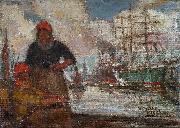 |
Eugeen Van Mieghem
|
|
(1 October 1875-1930) was a Belgian artist born in the port of Antwerp. As a boy Van Mieghem was confronted with the harsh reality of life at the waterfront.
Even at primary school he showed a talent for drawing. He was introduced to the work of Vincent van Gogh, Georges Seurat, Camille Pissarro, Henri de Toulouse-Lautrec and others at an exhibition organised by Flemish painter and architect Henry van de Velde at the Antwerp Academy around 1892. He attended the Antwerp Academy but was sent from school because his conservative teachers disliked his subject matter and his free, spontaneous way with it. He threw his lot in with progressive political and cultural movements, and joined an anarchist group. By the early 1900s was recognized as one of the most promising young artists of the Antwerp school. He would never renounce his idealism. He became the artist of the typical harbour folk: sack porters, sack makers, emigrants, dockers, bargees, and tramps.
Van Mieghem had his first taste of real success at La Libre Esthetique in Brussels, where his pastels and drawings hung alongside works by French impressionists such as Claude Monet, Paul Cezanne, Camille Pissarro, Jean Renoir and Edouard Vuillard.
|
|
 |
Ettore Tito
|
|
(17 December 1859-26 June 1941) was an Italian artist particularly known for his paintings of contemporary life and landscapes in Venice and the surrounding region. He trained at the Accademia di Belle Arti in Venice and from 1894 to 1927 was the Professor of Painting there. Tito exhibited widely and was awarded the Grand Prize in painting at the 1915 Panama CPacific International Exposition in San Francisco. In 1926 he was made a member of the Royal Academy of Italy. Tito was born in Castellammare di Stabia in the province of Naples and died in Venice, the city which was his home for most of his life.
|
|
|
|
|
|
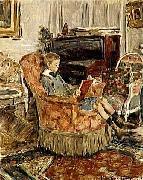 |
Etienne Moreau-Nelaton
|
|
Adolphe Etienne Auguste Moreau-Nelaton (2 December 1859, Paris- 25 April 1927, Paris) was a French painter, art collector and art historian. His large collection is today held in its entirety by National French museums.
Moreau-Nelaton's family's art collecting began with his grandfather Adolphe Moreau (1800-59). As a stockbroker he possessed ample capital with which to buy the work of artists with whom he was personally acquainted, including Eugene Delacroix and Alexandre-Gabriel Decamps. Moreau-Nelaton's father, who was also named Adolphe Moureau (1827-82), was a high government official and led the railroad company Chemins de fer de l'Est. In 1856 he married the ceramic artist Camille Nelaton (1840-97), with whom he further expanded the family's collection.
|
|
|
|
|
|
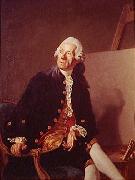 |
Etienne Aubry
|
|
Etienne Aubry, who was born at Versailles in 1746, studied under J. A. Silvestre and Joseph Vien, and soon became noted for his portraits and genre subjects. He exhibited several works of great merit at the Salon; but his life was cut short in its prime in 1781, in which year he had exhibited the 'Parting of Coriolanus from his Wife.'
|
|
|
|
|
|
 |
Estevao Silva
|
|
Estevao Roberto da Silva (Rio de Janeiro, c. 1844 - idem, 9 de novembro de 1891) foi um importante pintor e professor brasileiro da segunda metade do seculo XIX. Primeiro pintor negro de destaque formado pela Academia Imperial de Belas Artes, notabilizou-se por suas naturezas-mortas, sendo considerado um dos maiores expoentes da arte brasileira no genero.
|
|
|
|
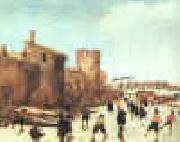 |
Esaias Van de Velde
|
|
1591-1630
Dutch
Esaias Van de Velde Gallery
Painter, draughtsman and etcher. He probably received his earliest training from his father. It is also possible that he studied with the Antwerp painter Gillis van Coninxloo, who moved to Amsterdam in 1595 (ten years after Esaias father). He may also have trained with David Vinckboons, whose work shows similarities with that of Esaias. Esaias became a member of the Haarlem Guild of St Luke in 1612, the same year as Willem Buytewech and the landscape painter Hercules Segers. During this Haarlem period Esaias had two pupils, Jan van Goyen and Pieter de Neijn (1597-1639), but by 1618 he had moved with his family to The Hague, where he joined the Guild of St Luke in October of that year.
|
|
 |
Esaias Boursse
|
|
1631-1672 Dutch
Dutch painter and draughtsman. Boursse was the son of Walloon parents, Jacques Boursse and Anne de Forest. A testimony of 23 July 1658 states that Esaias brother Jan provided for his artistic training. There is nothing to confirm a view of the early 20th-century scholars Bode, Bredius and Valentiner that Boursse was a pupil of Rembrandt, although the two artists may have had some contact, since Rembrandt lived near Jan in Amsterdam. According to an inventory of 24 November 1671, Jan collected a number of paintings, drawings and etchings by Rembrandt.
|
|
 |
ES, Jacob van
|
|
Flemish painter (b. ca. 1596, Antwerpen, d. 1666, Antwerpen)
Flemish painter. Together with Osias Beert and Clara Peeters, he was one of the leading representatives of the archaizing trend in Flemish still-lifes. His birthplace is known from the text on an engraving by Wenceslaus Hollar after a painting by Jan Meyssens (1612-70). Van Es became a master in Antwerp in 1617 but did not join the Guild of St Luke until 1645. Jacob Gillis and Jan van Thiene were his pupils in 1621 and 1623 respectively. He enjoyed a certain esteem among fellow artists, for Jacob Jordaens, Cornelis Schut the elder and Deodaat del Monte were godfathers to his children. Numerous mentions of works by van Es in inventories of 17th-century Antwerp collectors further testify to his success
|
|
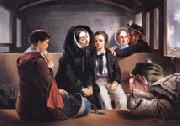 |
Erskine Nicol
|
|
British Genre Painter , (1825-1904)
was an Irish/Scottish painter. A student of William Allan, Nicol taught in Dublin, Ireland, from 1845-50, at the height of the Irish famine, and considered himself as much Irish as he was Scottish. Much of his work portrays the injustices inflicted upon the Irish population during the 19th century. He was made an Associate of the Royal Scottish Academy in 1855 and an Academician in 1859. Nicol exhibited at the Royal Academy and was made an Associate of the Royal Academy in 1866
|
|
 |
Ernst William Christmas
|
|
(1863-1918) was an Australian painter. He was born near Adelaide, South Australia in 1863 and studied art in Adelaide, Sydney and in London. He painted widely in England, exhibiting in the early years of the century at the Royal Academy, the Royal Institute of Oil Painters, the Royal Society of British Artists, the Royal Glasgow Institute of Fine Arts and in the provinces.
He was elected to the British Royal British Academy in 1909. In 1910-11, he painted mountains and lakes in Argentina and Chile. He lived in San Francisco around 1900 and again around 1915. He was an avid traveller, but spent the last two years of his life in Hawaii, where he painted landscapes including dramatic volcano scenes. Ernest William Christmas died in Honolulu in 1918.
|
|
|
|
|
|
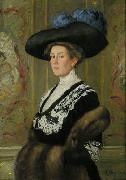 |
Ernst Oppler
|
|
1867, Hannover - 1929, Berlin, a Jewish German painter and etcher; elder brother of Alexander.
|
|
|
|
 |
Ernst Ludwig Kirchner
|
|
German Expressionist Painter and Sculptor, 1880-1938 was a German expressionist painter and printmaker and one of the founders of the artists group Die Brucke or "The Bridge", a key group leading to the foundation of Expressionism in 20th century art. He volunteered for army service in the First World War, but soon suffered a breakdown and was discharged. In 1933, his work was branded as "degenerate" by the Nazis and in 1937 over 600 of his works were sold or destroyed. In 1938 he committed suicide. In 1913, the first public showing of Kirchner's work took place at the Armory Show, which was also the first major display of modern art in America. In 1921, U.S. museums began to acquire his work and did so increasingly thereafter. His first solo show was at the Detroit Institute of Arts in 1937. In 1992, the National Gallery of Art, Washington, held a monographic show, using its existing collection; a major international loan exhibition took place in 2003. In November 2006 at Christie's, Kirchner's Street Scene, Berlin (1913) fetched $38 million, a record for the artist.
|
|
 |
Ernst Josephson
|
|
1851-1906
Swedish
Ernst Josephson Gallery
was a Swedish painter from a prominent Jewish family, whose main work was done on portraits and paintings of folk life.
He did his art studies in Italy, France and the Netherlands, among others, and is reputed to have said at the age of 20: "I will become Sweden's Rembrandt or die."
However, his life was marred by illness. He contracted syphilis at a relatively young age, and in 1888 he became mentally ill during a visit to Brittany, having religious hallucinations and believing that he was God and Christ.
He was later taken to hospital in Uppsala and diagnosed with schizophrenia, but continued working throughout his disease, often while in a trance-like state.
He also wrote poetry, in the collections Svarta rosor (1888, Black Roses) and Gula rosor (1896, Yellow Roses). His main work, Strömkarlen (1884, the Nix), was refused by the Swedish National Museum in Stockholm - however, Prince Eugen, Duke of Narke, bought the painting in fury over the decision.
Grandfather of Erland Josephson.
|
|
|
|
 |
Ernst Fries
|
|
(22 June 1801 Heidelberg - 11 October 1833 Karlsruhe) was a German painter.
Fries was a pupil of Karl Kuntz at Karlsruhe, and afterwards studied in Munich and in Italy. Examples of his work are: eA View of Tivoli, Sorrento and the House of Tasso, The Waterfall of Liris at Isola di Sora, The Castle of Massa, and A View of Heidelberg.
|
|
|
|
|
|
|
|
 |
Ernest Meissonier
|
|
Lyons 1815 - Paris 1891.
French Academic Painter, 1815-1891.
Lyons 1815 - Paris 1891. French Academic Painter, 1815-1891. French genre and military painter. His study of the Dutch masters was evident in his first Salon-exhibited painting, A Visit to the Burgomaster (1834). His small genre paintings are meticulous as to furnishings and costumes. Among Meissonier's battle scenes, chiefly of the Napoleonic Wars, are Napoleon I with His Staff (Louvre) and Friedland, 1807 (Metropolitan Mus.).
|
|
 |
Ernest Lawson
|
|
1873-1939
Ernest Lawson Galleries
Ernest Lawson (March 22, 1873 ?C December 18, 1939) was a Canadian-American painter and a member of The Eight, a group of artists which included the group's leader Robert Henri, Everett Shinn, John Sloan, Arthur B. Davies, Maurice Prendergast, George Luks, and William J. Glackens.
Lawson was born in Halifax, Nova Scotia. Though Lawson mostly painted landscapes, he also did some realistic urban scenes which were shown at the 1908 exihibition of The Eight. His painting style is heavily influenced by Impressionism, especially the style of John Henry Twachtman, Alfred Sisley, and J. Alden Weir.
Lawson exhibited as a member of the Canadian Art Club from 1911 to 1915. He died in Miami Beach, Florida in 1939.
|
|
 |
Ernest Laurent
|
|
(June 8, 1859 -- June 25, 1929) was a French painter and printmaker. He was born in Gentilly and died in Bievre.
Laurent was a neo-impressionist artist whose main influences were his instructor Ernest Hebert and his friend Georges Seurat. Laurent took second prize in the Prix de Rome in 1889 and in 1890, Laurent arrived in Rome, where Hebert remained Director of the Academie de France. From Rome, he went to Assisi where he underwent a mystical experience. It would profoundly influence his art. The work he returned to Paris from Assisi was noted for its religious themes.
Over time, profound religious devotion influenced his artistic motif and religious symbolism and scenery crept into his work. This aspect of his life ran counter to Seurat's materialism and the two parted ways.
|
|
 |
Ernest Hebert
|
|
1817-1908
French
Ernest Hebert Gallery
He was born in Grenoble and died in La Tronche. His painting Mal aria was exhibited in the Salon of 1850-1851, and now hangs in the Musee d Orsay, Paris. Painted in a Romantic style, it depicts a family of Italian peasants escaping an epidemic by raft, a scene inspired by events Hebert had witnessed while in Italy.
His student Paul Trouillebert was an important artist of the Barbizon School.
The artist house is preserved in the Musee Hebert in the VIe arrondissement of Paris. There is another museum near Grenoble.
|
|
 |
Ernest Fuhr
|
|
A popular illustrator of the period and this is classic patriotic art . 1874-1933
|
|
|
|
 |
Ernest Duez
|
|
1843-1896
French
Ernest Duez Location
French painter. He studied under Isidore-Alexandre-Augustin Pils and made his debut at the Salon in 1868. One of his earliest paintings, The Honeymoon (1873), caused a scandal at the Salon owing to its depiction of two lovers in modern dress walking through a sunlit forest. His triptych St Cuthbert (1879; Paris, Pompidou) was hailed as a masterpiece of modern art and bought by the State for the Musee du Luxembourg in Paris. The painting depicts the stages of St Cuthbert life, from child to hermit. Contemporary viewers were struck by the artist use of a real landscape setting, based on Villerville in Normandy where Duez spent much of his time. In addition to genre, religious and history paintings, in 1876 he began to produce portraits: Alphonse de Neuville (1880; Versailles, Cheteau) is a typical example. His brooding, suggestive portrait of Mme Duez (1877; see Montrosier, 1896, p. 429) shows the influence of Symbolism. However, he soon returned to painting works that were essentially landscapes, such as the decorative panel Virgil Seeking Inspiration in the Woods (1888) for the Sorbonne and a pair of allegorical figures, Botany and Physics (1892), for the Hetel de Ville in Paris. He also devoted time to applied art, producing a variety of textile designs. His work was praised for its adept use of colour and for bringing what were seen as modern techniques to traditional subjects.
|
|
 |
Ernest Crofts
|
|
English Painter , b. 15 September 1847- d. 19 March 1911
was an English painter who specialized in battle scenes. Ernest Crofts, RA lived at 'The Green' which he helped to re-design, next to Blythburgh church in Suffolk.
|
|
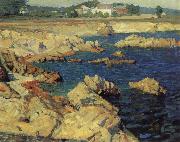 |
Ernest Bruce Nelson
|
|
American,a native of Northern California and a graduate of Stanford University
1888-1952
|
|
|
|
|
|
|
|
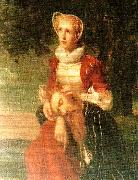 |
Erik Johan lofgren
|
|
Erik Johan Löfgren (15. lokakuuta 1825 Turku -- 10. joulukuuta 1884) oli suomalainen taidemaalari.
Löfgrenin vanhemmat olivat kauppias Johan Gabriel Löfgren ja Katarina Erikintytär o.s. Vahlsten. Hän opiskeli T. J. Leglerin johdolla Ruotsin kuninkaallisessa taideakatemiassa Tukholmassa 1842?C1850 ja sitten D??sseldorfin taideakatemiassa O. Mengelbergin ja F. Th. Hildebrandtin johdolla 1853?C1858.
Löfgren toimi taulujen restauroijana Tukholmassa 1842?C1853 ja myöhemmin 1870-luvulla hän oli opettajana Helsingin yliopiston piirustussalissa. Hänen maalaustyylinsä oli lyyrisen romanttista ja hän maalasi muotokuvia sekä historian tapahtumista aiheensa saaneita maalauksia.
|
|
 |
Erik Henningsen
|
|
(29 August 1855 - 28 November 1930) was a Danish painter and illustrator. He is best known for his Social Realist paintings of poor and exposed groups in the 1880s and 1890s. He was the younger brother of Frants Henningsen who was also a painter.
Erik Henningsen was born on 29 August 1855 in Copenhagen to Frants Ludvig Henningsen (1820-1869), a grocer, and Hilda Charlotte Christine ne Schou (1824-1880). He showed an early artistic talent and was articled to decorative painter A. Hellesen. He also took drawing lessons privately with C. V. Nielsen and was admitted to the Royal Danish Academy of Fine Arts in 1873. He graduated in 1877 and won several awards and distinctions, including the Academy's Annual Medal in 1887 and 1890, the Ancher Prize in 1889.
|
|
|
|
|
|
|
|
|
|
|
|
|
|
|
| Wholesale China Oil Painting Wholesale Oil Painting China Xiamen Portrait Reproduction on canvas Chinese Oil Painting Wholesale USA Oil Painting |
|
|
|
|
|